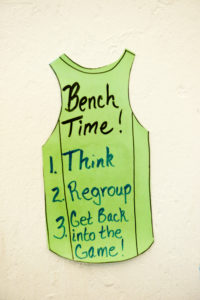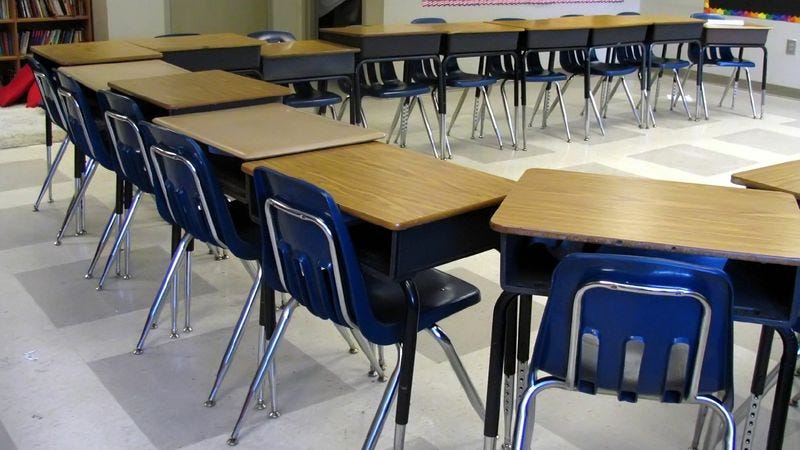Time Out (also known as Take a Break or Rest and Return) is a strategy that is used by classroom teachers to help disruptive students calm down and reflect on their behavior by removing them from the group. What makes this strategy so different from most classroom management strategies is that it allows students the opportunity to collect themselves by moving away from instruction until they are ready to return to the lesson and stay on task instead of shaming or punishing the child. In other words, the teacher can still continue instruction while the student focuses on his or her behavior. Because the term “Time Out” can have such a negative connotation from previous experience, it is probably best to refer to it as “Take a Break” or “Rest and Return”. Throughout this article, I will refer to the strategy as Rest and Return because I believe the best way to define its purpose.
What is Responsive Classroom Time Out?
As it says in the article, it is important to model what is expected when a student “Rests and Returns.” In the article, there is a set of expectations displayed on a poster in the shape of Jersey that says: “Bench, Regroup, and Get Back into the Game” (displayed at the bottom of the page). When the teacher sees a student who is disruptive during instruction, the teacher should model how the student should walk over to the designated spot to Rest and Return and reflect on the behavior. Then, the teacher should model thinking aloud to show how students should reflect on their actions to allow them to return to instruction. The teacher should model the student asking his or herself what they are doing, why it is disruptive, and how they can change their behavior. The teacher might even create a handout with these questions. The teacher may even use stress balls to help these students calm down to rejoin the rest of the group. While students are in Rest and Return, they may even use strategies like taking deep breaths or visualizing their favorite place to help them calm down. The article also suggests allowing them to doodle, and if that will help the student to calm down and get back on task, that could be a good strategy. However, in some cases, I feel this may be more of a reward for some students because they are drawing instead of listening to instruction. Then again, if it is properly modeled, maybe this could work for some students.
As a student teacher, I saw how my cooperating teacher would use Rest and Return with her students. When she would pull them to an area of the room for a whole-group lesson, and when she would have a student misbehave, she would tell the student to go back to his or her seat and come back to the lesson when they are ready. The strategy was effective because the students would come back exactly when they were ready. Some students would take more time than others, but they were able to calm themselves down and come back to instruction. I thought this was a great classroom management strategy because it allowed students the opportunity to reflect on their behavior and calm themselves down instead of shaming the students for their disruption. She allowed them the opportunity to Rest and Return until their behavior was under control. As a teacher, I thought this would be a really good strategy to use because it does not punish the students unlike some other classroom management strategies. When I have my own classroom, I want to have my classroom arranged in a whole-group circle so that when we have class discussions, we can all face each other. When a student disrupts my lesson, I thought it would be a good idea to have the student pull the desk out of the circle to help them calm down. At first, this may sound like it takes the form of humiliation, but the method is all in how the teacher communicates it to the students. I would make sure that my students know that I am not punishing them by removing them from the circle. Instead, I am giving them the opportunity to help calm them down and get ready to come back for instruction. It is important for a teacher to tell students the purpose of such classroom management procedures so that they know why the teacher chooses such strategies to control his or her class. Thus, the teacher must tell the students that they are not in trouble when they Rest and Return.
This image best shows how I want my classroom set up.
The article also talks about using a calming corner as a spot for Rest and Return in which there are chairs and bean bags. This might be a more relaxing space to help students calm down and return to instruction. This way, students are not away from instruction and they have opportunity in that calming corner to help them regain focus. I like that strategy a little bit better because it does not make it look like they are being isolated from the rest of the class unlike my idea of having them pull their desk away from the rest of the group. Also, it gives them a more calming space to help them regroup and return to the lesson. At the same time, I feel like with my classroom set up in a large circle, it communicates by them disrupting the class, they are choosing not to be a part of the class. Either way, it is important for the students to know that Rest and Return is not a punishment, but an opportunity for the student to reflect on his or her behavior. I am a proponent of using the strategy in both ways, but I guess we will have to see which way works best when I have my own classroom.
Out-of-Class Rest and Return
Some teachers like to send students to another teacher’s room for Rest and Return. I believe that most Rest and Return cases should be handled within the classroom. I read an article called Why You Shouldn’t Send Students Out of Class for Time-Out by Michael Linsin, and all of his reasons for not sending students out of class for Time Out or Rest and Return make sense. They miss instruction, and although the students are misbehaving, they need instruction just as much as any student in your class. In-class Time Out is more beneficial because the students are still getting instruction while in Time Out. He also says that “It is the weaker consequence”, meaning that students are escaping instruction rather than being separated from the rest of the class and unable to participate. By sending them out of the class, we are giving them an escape rather than an opportunity to get back on task. As teachers, we want students to get back on task and learn rather than escape learning. Linsin also points out that the teacher will not know if the student is ready to return to instruction if the teacher is not in the classroom to say that the student is ready. When my cooperating teacher uses Rest and Return, she allows the students to come back to the lesson once they feel they are ready to come back. I like this method of Rest and Return because it allows students to choose when they are ready to come back. In other words, it lets them practice self-regulation and helps them become aware of their own emotions. Of course, the students are in third and fourth grade. On the contrary, children in primary grades (K-2) may not know when they are ready to return to instruction because they still need guidance in developing those self-regulation skills. Therefore, it is probably best children that young are not out of the room for Rest and Return so the teacher can judge when they are ready to rejoin the class.
For the most part, it is probably best that students stay in class for Rest and Return. At the same time, there are certain behaviors that should not allow a child to stay in the classroom. For example, if the child is yelling; kicking; screaming; or physically harming another child, that child should be removed from the classroom at once because in that case, the disruption has become extreme. The teacher and the other students cannot focus on instruction because the behavior is too strong for everyone in the room to focus. The Responsive Classroom strategy Buddy Teachers lets students go into another teacher’s classroom so that they can calm down. This strategy is only used when the disruptions become so extreme that the teacher cannot teach and the other students cannot learn. When a teacher uses a buddy teacher, the role of the buddy teacher is to calm the disruptive student down while the teacher continues instruction. The article also mentions that it should be clearly stated to the student that they have a buddy teacher when needed, so that when a student is being disruptive, another student can get the buddy teacher to help calm the disruptive student down.
I think that the buddy teacher strategy is a good strategy for those behaviors that are out of control; however, it is a strategy that should be used as a last-resort because it is important that the student gets as much instruction as possible while the student is not causing any major disruptions. If stress balls, doodling, deep breaths, and visualizing the student’s favorite place are not working; the teacher should probably send a student to get the buddy teacher to help. Of course, the buddy teacher would have to be someone who has a prep during the time of the misbehavior because a misbehaving student in one teacher’s class may disrupt another teacher’s class. This might be a lot of planning to find a buddy teacher during certain periods of the day because no teacher is free all day. With that said, the teacher should probably find the buddy teacher (or buddy teachers) with a schedule that would allow them to help with any misbehaving students. If it is hard to find a buddy teacher, hopefully, school counselors and administrators can help with the situation. With that said, out-of-class Rest and Return should be used sparingly if in-class Rest and Return procedures do not work.


